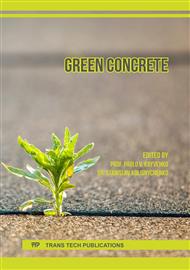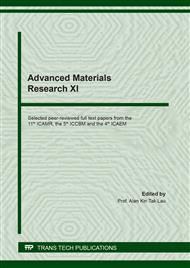p.61
p.67
p.73
p.85
p.95
p.103
p.109
p.115
p.121
Durability and Mechanical Properties of Self-Compacting Concrete Incorporating Recovered Filler from Hot Mix Asphalt Plants and Recycled Fine Aggregate
Abstract:
In this research, a sustainable approach is followed to develop efficient mixtures incorporating recycled fine aggregate (RFA) remained from structure demolition as well as limestone filler (LF) from production of hot mix asphalt (HMA). The LF is a byproduct of the drying process in HMA production plant which is not entirely consumed in the production of the HMA and must be hauled and disposed in landfills. The maximum particle size of the LF is approximately 40 µm. Self-Compacting Concrete (SCC) mixtures were designed replacing 5% and 10% of the cement with LF. Incorporation of 50%, and 100% RFA with the fines in the mixtures were considered with and without addition of the LF. Due to the formwork and prefabrication restrictions, the paste volume and the high range water reducer content were tuned in such a way that the slump flow of the mixtures remained between 660 mm to 700 mm without segregation. Durability and mechanical performance of the mixtures were evaluated by resistance against freeze-thaw scaling exposed to deicing agents and compressive strength. It was observed that the SCC mixtures containing 10% LF outperformed those without the use of LF while 5% SCC mixtures did not exhibit tangible superiority. Incorporation of RFA as the fine fraction degraded the durability of all the mixtures. While replacing all the fine fraction with RFA significantly impaired durability and compressive strength, 50% RF mixtures could be designed containing 10% LF that remained in the allowable limits.
Info:
Periodical:
Pages:
95-101
Citation:
Online since:
July 2021
Authors:
Keywords:
Price:
Сopyright:
© 2021 Trans Tech Publications Ltd. All Rights Reserved
Share:
Citation:



